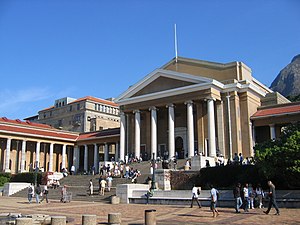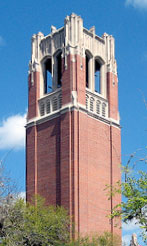 Image via Wikipedia
Image via WikipediaPresenter(s):
Amber Evans (
Virgina Tech)
M. Aaron Bond (Virginia Tech)
Karen Swenson (Virginia Tech)
Description: Dr. Karen Swenson, a 2010 Teaching With Sakai Innovation Award finalist, uses the Sakai wiki with her students to "think about important issues presented through works of speculative fiction," but has found there is even more to her students than the wiki reveals. Although the course goals include collaborative work to "reconsider traditional concepts of 'author' and 'self,' working together to build a better world, encourage a sense of community, and become aware of others contributions" her recent collected data provides insight as to "who" are these students in her Sakai Wiki community. Come to this session to see the paradigms that underlie the structure of the course, what the students do with the Wiki in class and after the semester ends, and who these students are (including demographics, previous wiki contributions, and perceptions of self, information technology, and active involvement in their learning process).
Presenter bios: Amber Evans: Currently pursuing a Ph.D. in Instructional Design and Technology. 15+ years experience in teaching, pedagogy, and technology. Professional and Faculty Development. Knowledgeable about (and doing research in) Diffusion of Innovations in Higher Education.
M. Aaron Bond: Aaron works as a member of the Instructional Design, Development & Support unit of the Institute for Distance and Distributed Learning (IDDL), as well as with other IDDL units to provide quality course development and support. He designs, develops, and delivers professional development activities for distance and distributed learning faculty. Aaron provides support to faculty, students, and staff engaged in distance and distributed eLearning at Virginia Tech and assists faculty with the design and development of instructional materials for online courses. He regularly meets with faculty and other members of the Virginia Tech community to assist in the planning and preparation for online courses. In each case, he works to assist in the effective integration of educational technologies into distance instruction.
+++++++++++++++++++
This presentation covered the design of the course - this was a collaborative site for a science fiction course. The wiki played a key component in the course. She covered basic instruction design principles around interaction.
Paradigms include behaviorism, cognitivism and constructivism. Chickering and Gamson (1987) and "
Cultivating communities of practice" Wenger, McDermott, and Snyder (2002).
Her course was a fully online course, 80 students, 15 weeks long. Wide variety of backgrounds among her students. She wanted her students to be engaged contributers. Students share ideas in the Discussion Forums and a speculative fiction wiki. There are reading quizzes because the reading is essential to the course.
The created course goals and objectives that included collaboration and community.
She spent a little time describing wikis. They are collaborative webpages. They used the wiki in Sakai. A wiki is a web page that can be viewed and modified by anybody with a web browser and access to the internet.
She calls information on wikis "relative truths" because the information can change.
She continued to talk about the mechanics of wikis.
The best feature is that the wiki can be exported and shared with others.
Rob talked about an instructor who had to download and scan to pdf a wikipedia to "freeze" the information in time. Information now has a temporal dimension.
The instructor has a guide to editing and "netiquette" for those edits and settling disputes. she has had no problems teaching the course over two years.
Challenges to wikis:
- They have to be monitored
- May need authorization
- Learning curve
- Lack of some features
- Content-focused - it is really ugly
- No hierarchy - like a concept map - there are no "contents" pages
- Collective group bias
- Remembering to use it
"Student writing has meaning, power, and significance in this course."
"
Wiki Aliveness"
1. design for evolution
2. open a dialogue between inside and outside perspectives
3. Invite different levels of participation
4. Public and private community spaces
5. Focus on value
6. Combine familiarity and excitement
7. Create a rhythm for the community
She created a handout for the students on what a wiki is all about, how to behave, how it works. The instructor has a very flexible grading philosophy, but there is a simple rubric for the wiki grading.
One feature suggestion would be to support "track user."
They collected student data on student demographics that coverted GPA, gender, major. 64% of their students had never used a wiki before. 14% use a wiki weekly. She went through survey data - one of the items was that 44% of the students do not like learning via websites, blogs, and wikis.
In general the students liked the course and the instructor. The students were participants in the course.
Their website is http://learn.vt.edu
 Image via WikipediaI know this is not a movie review blog, but this is not really a movie review. I am on "vacation" in Chicago this week and one of the things I like to do on vacation is catch up on movies. German movie director Werner Herzog has shown up in this blog previously for his "Rogue Film School" and here in Chicago, I finally got around to seeing "Cave of Forgotten Dreams." There are so many reasons why this is an important film. The first of which is that it is a record of the oldest known artistic production of our species. The cave paintings are 35,000 years old, twice as old as the cave paintings in Lescaux. The cave is being protected by the French government because of what tourism has done to the paintings in Lescaux. The movie is filmed in 3-d. For myself, I think this is the first real use of 3-d since we have been making 3-d films. There are a couple of entertaining 3-d films out there, but this is the first time the technology has been used to completely situate one's experience of the film's subject matter. The 3-d technology is not just used as an effect or a gimmick; it is the core experience of the film from beginning to end. By using 3-d even in interviews with people in their offices or outdoors, it allows the viewers the chance to orient themselves to the medium when he is filming in the cave. I found the experience profoundly moving. The film has its eccentricities: philosophical hyperbole and a bizarre post-script, but this is a film by an artist, not National Geographic. And that is my next point: I always thought that NASA should send artists, musicians, and/or poets into space. Monkeys, test pilots, and chemists all seem to be unable to really communicate the significance or the meaning of their work. They do not seem to be interested in that at all anyway. In the past, art and science were a lot closer (I am thinking of Leonardo for instance). The French government made a brilliant decision by letting Werner Herzog have access to the cave.
Image via WikipediaI know this is not a movie review blog, but this is not really a movie review. I am on "vacation" in Chicago this week and one of the things I like to do on vacation is catch up on movies. German movie director Werner Herzog has shown up in this blog previously for his "Rogue Film School" and here in Chicago, I finally got around to seeing "Cave of Forgotten Dreams." There are so many reasons why this is an important film. The first of which is that it is a record of the oldest known artistic production of our species. The cave paintings are 35,000 years old, twice as old as the cave paintings in Lescaux. The cave is being protected by the French government because of what tourism has done to the paintings in Lescaux. The movie is filmed in 3-d. For myself, I think this is the first real use of 3-d since we have been making 3-d films. There are a couple of entertaining 3-d films out there, but this is the first time the technology has been used to completely situate one's experience of the film's subject matter. The 3-d technology is not just used as an effect or a gimmick; it is the core experience of the film from beginning to end. By using 3-d even in interviews with people in their offices or outdoors, it allows the viewers the chance to orient themselves to the medium when he is filming in the cave. I found the experience profoundly moving. The film has its eccentricities: philosophical hyperbole and a bizarre post-script, but this is a film by an artist, not National Geographic. And that is my next point: I always thought that NASA should send artists, musicians, and/or poets into space. Monkeys, test pilots, and chemists all seem to be unable to really communicate the significance or the meaning of their work. They do not seem to be interested in that at all anyway. In the past, art and science were a lot closer (I am thinking of Leonardo for instance). The French government made a brilliant decision by letting Werner Herzog have access to the cave. Image via Wikipedia
Image via Wikipedia













